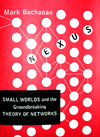Serendip is an independent site partnering with faculty at multiple colleges and universities around the world. Happy exploring!
Nexus: Small Worlds and the Groundbreaking Theory of Networks

|
Serendip's Bookshelves |
 Mark Buchanan, Nexus: Small Worlds and the Groundbreaking Theory of Networks, W.W. Norton and Co., 2002 Mark Buchanan, Nexus: Small Worlds and the Groundbreaking Theory of Networks, W.W. Norton and Co., 2002
Commentary by Paul Grobstein. |
"One of the messages of this book ... is that it may be possible to discover mathematical laws and meaningful patterns in the human world ... over the past five years, sociologists, physicists, biologists, and other scientists have turned up numerous unexpected connections between the workings of the human world and the functioning of other seemingly unlreated things: from the living cell and the global ecosystem to the Internet and the human brain. This is not to say that we lack free will, or that Karl Popper was wrong and history can be predicted. But it does suggest that many of the inherent complexities of human society actually have little to do with the complex psychology of humans; indeed similar patterns turn up in many other settings where conscious beings play no role at all" ... page 12
"Six degrees of freedom", a "small world", and a "fat curve" (a "scale-free" distribution) are the key concepts of this book, which does indeed suggest that it is becoming increasingly possible to make sense of aspects of human behavior in the same terms that one uses to make sense of a variety of non-human phenomena. This is not "reductionism", but something more akin to realizing that humans participate in "networks" and that there are general principles of network function which tend to hold whether the networks are made up of humans or anything else.
It is also not "mathematical laws" in the old sense of the word but rather the continuing development of a new mathematics, theory of "information", and way of looking at the world that has been greatly accelerated by the advent of easily available computing power. The early phases of this evolution were well described in Complexity: The Emerging Science at the Edge of Order and Chaos by M. Mitchell Waldrop (Simon and Schuster, NY, 1992), and more recent ones equally clearly laid out in Steven Johnson's Emergence: The Connected Lives of Ants, Brains, Cities, and Software (Scribner, 2001). Like Waldrop and Johnson, Buchanan is a science writer rather and so is able to both describe and synthesize in ways that make his account of significant intellectual change both accessible and valuable.
Is there enough action in this area for ... two books within a year of one another? Yep, recognizing that "over the past five years" misrepresents a bit the historical antecedents, Buchanan has provided a useful update on Johnson (and he in turn on Waldrop), coming at similar issues from a different perspective and making it clear in what somewhat unpredictable ways future work is likely to go.
Shades of Herman Hesse's Magister Ludi: The Glass Bead Game (1943) and Isaac Asimov's Foundation Trilogy (c 1950) ... perhaps we are in fact getting closer to a time when our stories of the universe and of ourselves become sufficiently intertwined to allow us to display both the humility and wisdom needed for our continuing evolution?

